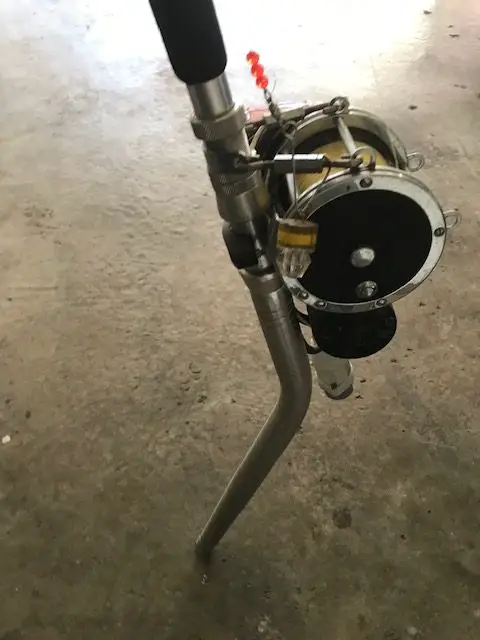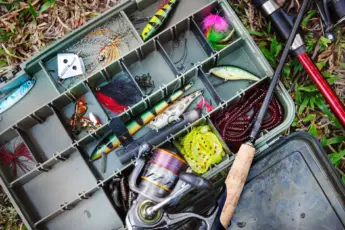Offshore fishing vessels are often equipped with rods which opposite of the ordinary. The lowest section is angled downward rather than a rod remaining straight from grip to tip. Trolling vessel fishing rods slide into rod holders preventing fish from running away with the rod and reel when fish strike. Rather than remaining vertical, bent butt rods are angled, keeping the tip lower. To make it clear, we are not talking about a fishing rod bent. Here is what you need to know about bent butt rods.
What Is The Purpose Of A Bent Butt Rod
Bent butts serve a multitude of purposes for anglers. When offshore fishing the Atlantic ocean off the coast of Georgia, South Carolina, and North Carolina, trollers deploy baits at different angles than straight butts. Don’t picture a bent fishing pole instead only the butt or bottom is bent.
Angle Of Attack
It is essential to understand that when offshore trolling, baits are frequently presented at the surface of the water. Artificial lures and rigged trolling baits dance across the top of the water-attracting strikes from dolphin, wahoo, tuna, sailfish, marlin, and more.
Rather than fishing the surface, bent butts allow the angler to fish at a more parallel attack versus verticle. A parallel approach allows the angler to fish beneath the surface with lead weights, wireline, or deep diving plugs. The boat is not required to be fitted with a bent butt rod holder. Instead, any gunnel mounted rod holder will serve the purpose.
Pressure Applied To The Tip
A vertically positioned rod is under tremendous force when combined with trolling leads or big lipped plugs.
The rod’s tip bends downward significantly, and when combined with a fish’s strike, the rod doubles over from the added strain. When fishing heavy weights or deep diving plugs, utilize rods fitted with bent butts.
Fighting Stance
Unlike battling offshore fish while standing wearing a fighting belt or seated in a fighting chair, rods fitted with bent butts require a different approach.
A bent butt fishing rod is typically heavier in weight when compared to stand-up gear. Rather than removing the rod from the rod holder, the angler stands next to the gunnel or sits on the gunnel of the boat.
While standing, the angler uses one hand to control the rod from swaying side to side, while the other hand turns the reel to retrieve the line.
When sitting on the gunnel, take caution to avoid falling into the water. Rolling waves and wet surfaces put anglers at greater risk of being tossed from the boat and into the sea.
Should Bent Butt Rods Be Secured To The Boat While Trolling
Despite bent butts or standard butt fishing rods being firmly seated in rod holders, they come free occasionally.
When high-speed trolling for wahoo, straps to secure the rod and reel from falling overboard are essential. Bent rod holders must be well seated in the gunnel and include a backing plate.
High-speed trolling is exactly as it sounds, moving the boat and lures fast through the water to entice a wahoo to bite.
With increased speed comes a greater risk of the rod and reel bouncing out of the rod holder, being pulled from the rod holder due to a strong bite, or accidentally dropping over the side when gaffing the fish.
Lanyards secure the rod to the boat by using clips and a stout line. One clip connects to the ring fitted beneath the reel while the other connects to a solid object, including a cleat on the boat.
Despise the reel becoming inundated with saltwater; the reel and rod avoid becoming lost to the bottom of the sea.
Never troll with bent butt rods without a tether line. We have fished extensively in offshore waters independently and with guests. No telling who puts the rod and reel most at risk. Humans and fish put an equal amount of risk on the high-cost gear.
When choosing a tether, we recommend the four-foot trolling rod safety leash. The line is fitted with a stainless steel clip on each end, allowing easy connections to the boat and rod. Lastly, the ¼” line is strong, eliminating the risk of parting and losing the combination to the sea.
What Are Bent Butts Made Of
When it comes to constructing bent butts, they must be durable and capable of resisting the harsh elements and, in particular, salt.
A bent fishing rod is constructed of aluminum which is strong, light in weight, and resist corrosion. However, when the metal comes in contact with painted surfaces or teak, it is prone to causing damage.
To avoid damaging the boat, carefully align the rod butt with the rod holder. Remember to rinse the rod butt, blank, and reel thoroughly after use.
When traveling with bent butt rods, place them in a bent butt rod rack mounted on a truck to prevent the reels from becoming damaged.
Now You Know About Bent Butt Rods
A bent butt rod is beneficial to anglers trolling the offshore waters of Georgia, South Carolina, and North Carolina. Bent butts are ideal for weighted lines, trolling heavy, leads and big lipped deep-diving plugs to prevent pulling them to the surface. The next time you’re headed out trolling in the deepsea, consider a bent butt rod.







